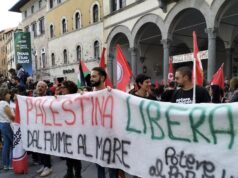“Save one million Jews! And to do what with them? Where will we put them?” By João Bernardo
I mentioned in the previous article that, during the time of the German-Soviet Pact, the Polish Jews that managed to escape from the Nazi-occupied areas of Poland to the areas occupied by the Red Army were deported or put in concentration camps, a sad fate, but at least they were accepted and nobody ever sent them back across the border. Far more sinister was the UK’s and the USA’s attitude.

During the time the Nazi regime was in power, the only possible measure was to relocate hundreds of thousands of European Jews to a safe haven. Since the Evian conference (organized by Franklin Roosevelt) in the summer of ’38 and until the end of the war, hundreds of relocation plans were elaborated and then shelved. The futility of these plans was due to the fact that, of the 32 nations attending the conference in Evian (including the USA and the UK), only the Dominican Republic agreed to take in any refugees. Each nation tried to pass the hot potato to the next, and so nothing was done.

Even though they never came to fruition, it is worth noting some of the projects proposed after the Evian conference. Some planned on sending the Jews to freeze in Alaska, whereas others wanted the Jews to settle down in the Guineas or another part of Africa, which reveals a dream common to all democracies – take advantage of the consequences of Nazi imperialist expansion to reinvigorate their own colonialism.
All things considered, there was not a lot the Jews trapped in the Reich could hope for. In May of 1939, four months before the beginning of the second world war, the St Louis sailed out of Hamburg carrying over 900 Jews who the Nazi authorities had given authorization to leave the country, and that had the hope of finding shelter in the USA. The American authorities turned the ship away, sending it to Havana, claiming that American public opinion would be against taking in more Jews since the immigration quotas according to the National Origins Quota Law (approved by Congress in 1924) were already full. At the time, the Cuban government followed American orders, and so refused to give asylum to the Jews and asked the vessel to leave the island. The captain then tried to go to Miami, where he was blocked from docking. The Canadian government also refused to let the Jews come ashore. There was no other option but to turn back, and the human cargo ended up being delivered to various European countries, where it would eventually be exposed to Nazi persecution.
The situation repeated itself in 1940, when a Portuguese vessel loaded with 80 Jews on the run was turned back from Mexican ports but still managed to unload most passengers in the USA. This served to toughen up the State Department’s position, to the point that in the middle of 1941, the official who handled these matters, an open admirer of Hitler and Mussolini and obsessed with a Jewish-communist conspiracy, boasted that he had blocked any further refugees. Effectively, while the war lasted, the American consulates granted less visas than the law allowed them to.

Maybe the first news of the genocide that was being inflicted on the Jews came from Thomas Mann, one of the most notable novelists of the last century, in a series of lectures given through the BBC in December 1941 and January 1942. But already in October 1941 the Allied press had received news of massacres happening in Ukraine under Nazi occupation, and in January 1942 the Soviet government had made public a report detailing all the actions perpetrated by the SS Death Squads in occupied territories. After that, reports flooded in, some scarier than others. A clandestine information network organized by the Jewish historian Emmanuel Ringelblum who was trapped in the Warsaw ghetto managed to send to Polish government officials in London documentation about one of the extermination camps, which gave rise to the BBC announcing in June 1942 that the Nazis had commenced the “final solution” policy. This allowed the Polish government in exile to present a report to the USA about the use of gas chambers and crematory ovens. Besides that, in July 1942 Allied secret services in Switzerland heard from a reliable German source that Hitler had ordered the extermination of the Jews. These reports and news were confirmed a short time later by documents coming from the World Jewish Council, and at the end of the year by news originating at the Jewish Agency for Palestine. Meanwhile, in November, Jan Karski arrived in London. He was a member of the Polish resistance who, with incredible audacity, had infiltrated one of the death camps and was able to describe the methods being employed by the Nazis which he had seen with his own eyes to the British minister for Foreign Affairs Anthony Eden, and also to the President of the USA. Evidence piled up and allowed a very precise analysis of the situation.

The first reaction of the American State Department was to delay and block for as long as possible the dissemination of all this information. Later the Secretary of State, or somebody in his name, even forbade the diplomatic channels to broadcast any similar news. Only in December 1942 did the Allies organize a joint statement on the “German policy of extermination of the Jewish race”, and from then on the governments of the USA and of the UK tried as best they could to underestimate the problem and delay any type of solution, refusing funding and means of transport to save the Jews. In April 1943 the Anglo-American conference in the Bermuda, called especially to discuss the questions raised by the genocide, abstained from proposing any efficient initiative. Finally, in January the following year the US government created the War Refugee Board, but compared to the immensity of the task the results were insignificant. “In reality”, said a team of experts, “both the British and the Americans, after organizing the Bermuda conference […], opposed any mass rescue plan for Jews in occupiedEurope”.
This policy of omission and deliberate negligence was followed by the Allies at all levels and in all circumstances. “I’ve come across a vast amount of material, some of it confidential, which deals with the difficult situation of the Jews in Europe that are being exterminated at an alarming rate, and the lack of possible escape routes for them, and it’s a very scary situation”, wrote a journalist in July of 1944 for a New York weekly paper.
In 1940, with the bizarre argument that an influx of Jews would stimulate the latent anti-Semitism in Great Britain and would end up being damaging to the Jewish community itself, the British Interior Minister, an important figure in the Labour Party, rejected a proposal from the French collaborationist government in Vichy, that would have allowed the emigration of Jewish children to the safety of Britain.

Near the end of 1941, when the Turkish ambassador in Bucharest suggested to the US representative that the Romanian Jews should be transferred to Palestine through Turkey, the American State Department refused to even convey this proposal to the British, claiming, among other reasons, the difficulties transporting all these people and also the possibility that the Jewish communities in other countries threatened by Nazism would ask for help and would “pressure for an asylum in the Western hemisphere”. In the first months of 1943, Sweden, a neutral country, offered to shelter 20,000 Jewish children from Nazi-occupied Europe, with the condition that either Great Britain or the USA paid for their living costs and would promise to relocate them after the war. The American government took so long to reply though that the opportunity was lost.
In March that year there was a new opportunity to save a large number of lives when Bulgaria announced that it would authorize their sixty or seventy thousand Jews to emigrate to Palestine, but once again the Allies did not take up that project.
A short while later, the German Ministry for Foreign Affairs offered to exchange 5,000 Jewish Slavic children for Germans held in British territory. This offer was refused by the government in London claiming that this deal was impossible since the children did not have British citizenship.
The July 1943 proposal of the Romanian fascist dictator Antonescu to sell sixty or seventy thousand Jews to the Allies for just 170,000 dollars was met with similar reluctance. The American State Department took eight months to authorize the Jewish organizations to deposit the promised funds in Swiss banks, but since in the meantime both the British Ministry of Foreign Affairs and the Ministry of War Production had opposed this move, quoting the “difficulty in sheltering a considerable number of Jews”, nothing was ever done.

Likewise, admiral Horthy, leader of the Hungarian fascist state, announced that with the agreement of the Reich’s authorities, he would allow the exit of all the Jews that had received visas from other countries, a total between 17,000 and 20,000 people, but the American and British governments took so long to reply that in the meantime the German army occupied the country and once again the democracies missed the opportunity to save Jewish lives.
Finally, in April 1944, when the Nazi economy was facing insurmountable obstacles, Heinrich Himmler, Reichsführer SS, Commissioner of German Nationhood and Reich Minister of the Interior, or in other words, the highest ranked person in the regime after Hitler, asked a Hungarian Zionist leader to present a proposal to the Western Allied powers in which he promised to spare the lives of a million Jews and authorize their emigration in exchange for 10,000 trucks to be used only in the Eastern front as well as vast quantities of coffee, tea, cocoa, soap and a few other articles. The Allies refused the deal and even arrested the middleman for a few months. Clearly the lives of the Jews were less important to them, and even less so having to find accommodation for a million refugees, compared to accelerating the defeat of the Reich’s transport capabilities. The British politician and businessman who was then resident minister in Cairo said, while interrogating the emissary: “Save one million Jews! And to do what with them? Where will we put them?”.
If several thousand foreign antifascists had been locked up by democratic governments in concentration camps; and if the Soviet authorities had deported or arrested and even put in work camps many more radical or even orthodox socialists and communists; and if the Jews that were able to escape had nobody to take them in, which facilitated tremendously the Nazi programme of extermination – would there be anybody left after the war to think of revolution?
Previous article here. Continues here.
References
The quote from a team of experts about the pointlessness of the Bermuda conference can be found in I. C. B. Dear and M. R. D. Foot (eds.) The Oxford Companion to the Second World War, Oxford and New York: Oxford University Press, 1995, page 864. The statement from the journalist I. F. Stone in the New Yorker weekly The Nation can be found in Katrina Vanden Heuvel and Hamilton dos Santos (eds.) O Perigo da Hora. O Século XX nas Páginas do The Nation, Sao Paulo: Scritta, 1994, page 245. The quotes about the attitude of the American State Department relatively to the proposal presented by the Turkish ambassador in Bucharest and about the reacton of the British Ministry of Foreign Affairs and Ministry of Wartime Economy regarding the proposal of marshal Antonescu are in Raul Hilberg, The Destruction of the European Jews, London: W. H. Allen, 1961, pages. 720 n. 19 and page 721, respectively. The quote from Lord Moyne, resident minister in Cairo, can be found in Henry L. Feingold, Bearing Witness. How America and Its Jews Responded to the Holocaust, Syracuse: Syracuse University Press. 1995, pages. 87-88. Readers interested in a more thorough analysis of these events can consult my own book called Labirintos do Fascismo. Na Encruzilhada da Ordem e da Revolta, Porto: Afrontamento, 2003, especially from page 675 onwards.
Translated by The Commune. Original here.





